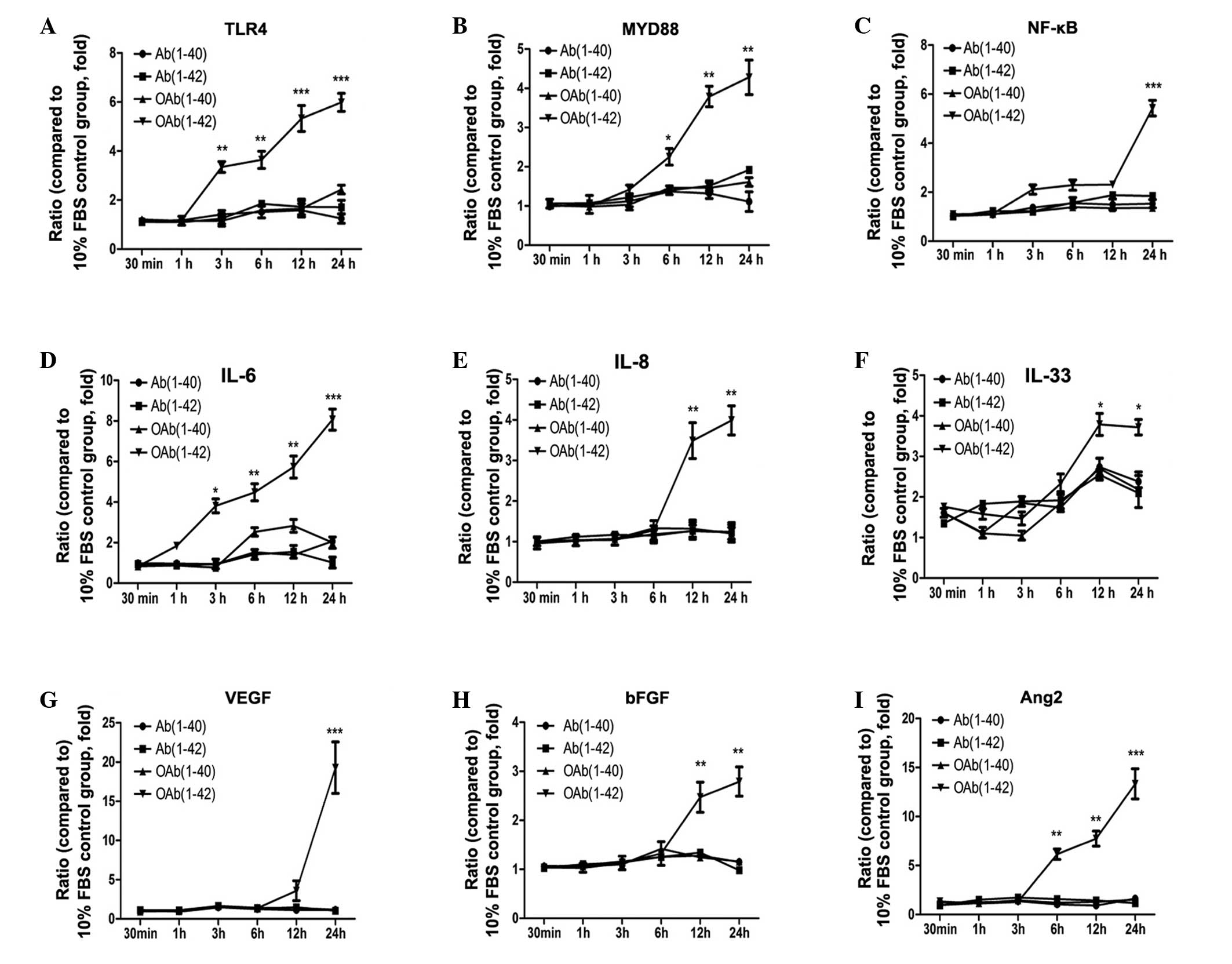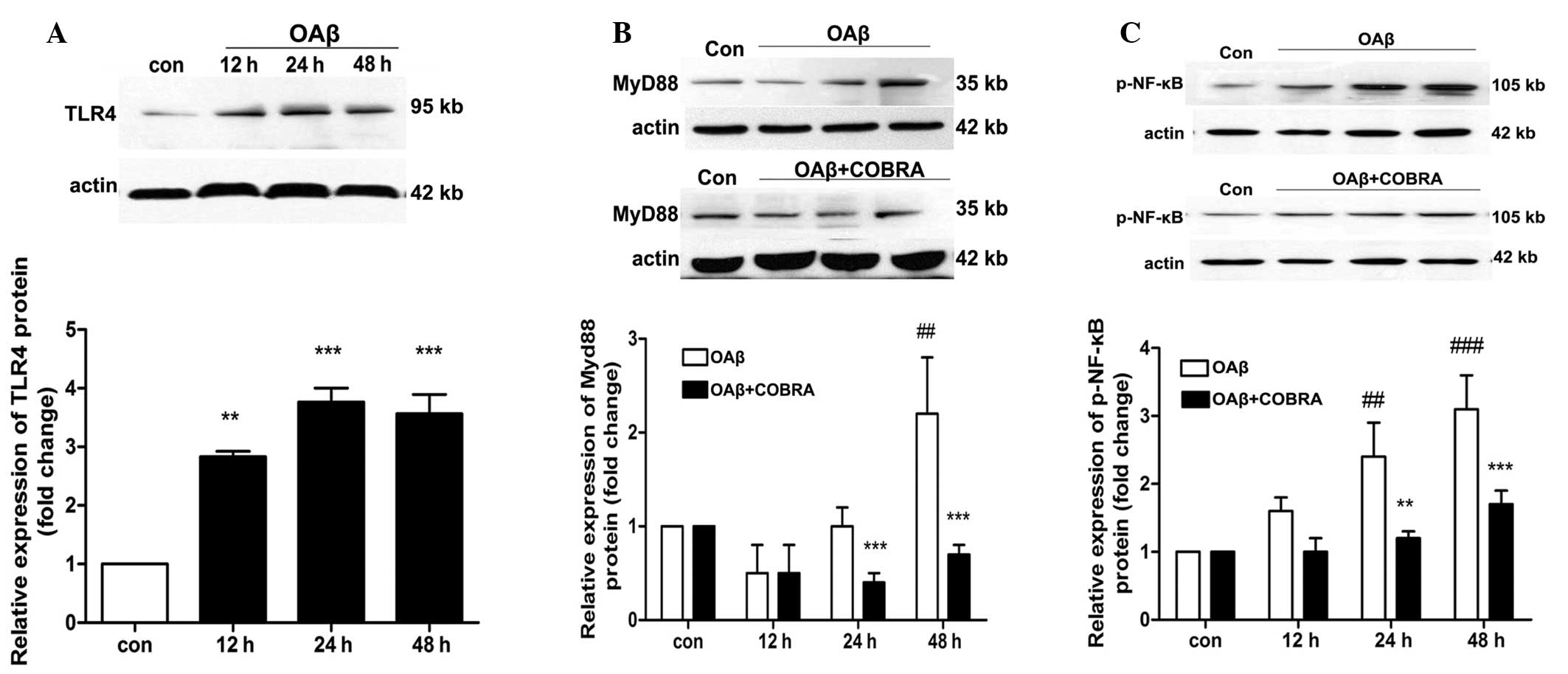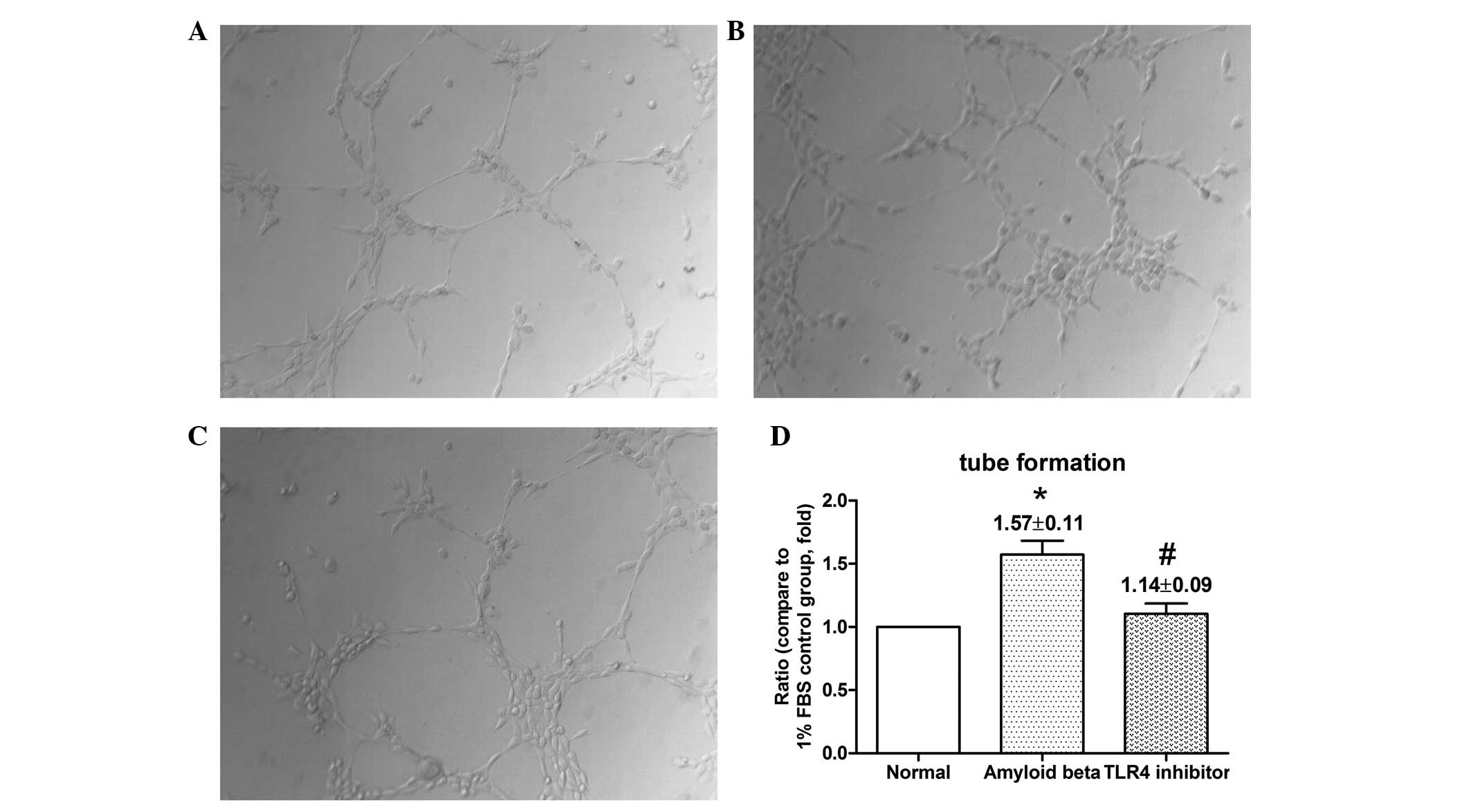|
1
|
Coleman HR, Chan CC, Ferris FL III and
Chew EY: Age-related macular degeneration. Lancet. 372:1835–1845.
2008. View Article : Google Scholar : PubMed/NCBI
|
|
2
|
Jager RD, Mieler WF and Miller JW:
Age-related macular degeneration. N Engl J Med. 358:2606–2617.
2008. View Article : Google Scholar : PubMed/NCBI
|
|
3
|
Bird AC, Bressler NM, Bressler SB,
Chisholm IH, Coscas G, Davis MD, de Jong PT, Klaver CC, Klein BE,
Klein R, et al The International ARM Epidemiological Study Group:
An international classification and grading system for age-related
maculopathy and age-related macular degeneration. Surv Ophthalmol.
39:367–374. 1995. View Article : Google Scholar : PubMed/NCBI
|
|
4
|
Bressler NM, Silva JC, Bressler SB, Fine
SL and Green WR: Clinicopathologic correlation of drusen and
retinal pigment epithelial abnormalities in age-related macular
degeneration. Retina. 14:130–142. 1994. View Article : Google Scholar : PubMed/NCBI
|
|
5
|
Ferreira ST, Vieira MN and De Felice FG:
Soluble protein oligomers as emerging toxins in Alzheimer's and
other amyloid diseases. IUBMB Life. 59:332–345. 2007. View Article : Google Scholar : PubMed/NCBI
|
|
6
|
Johnson LV, Leitner WP, Rivest AJ, Staples
MK, Radeke MJ and Anderson DH: The Alzheimer's A beta-peptide is
deposited at sites of complement activation in pathologic deposits
associated with aging and age-related macular degeneration. Proc
Natl Acad Sci USA. 99:11830–11835. 2002. View Article : Google Scholar
|
|
7
|
Yoshida T, Ohno-Matsui K, Ichinose S, Sato
T, Iwata N, Saido TC, Hisatomi T, Mochizuki M and Morita I: The
potential role of amyloid beta in the pathogenesis of age-related
macular degeneration. J Clin Invest. 115:2793–2800. 2005.
View Article : Google Scholar : PubMed/NCBI
|
|
8
|
Teplow DB, Lazo ND, Bitan G, Bernstein S,
Wyttenbach T, Bowers MT, Baumketner A, Shea JE, Urbanc B, Cruz L,
et al: Elucidating amyloid beta-protein folding and assembly: A
multidisciplinary approach. Acc Chem Res. 39:635–645. 2006.
View Article : Google Scholar : PubMed/NCBI
|
|
9
|
Hoyer W, Grönwall C, Jonsson A, Ståhl S
and Härd T: Stabilization of a beta-hairpin in monomeric
Alzheimer's amyloid-beta peptide inhibits amyloid formation. Proc
Natl Acad Sci USA. 105:5099–5104. 2008. View Article : Google Scholar : PubMed/NCBI
|
|
10
|
Gouras GK, Olsson TT and Hansson O:
β-Amyloid peptides and amyloid plaques in Alzheimer's disease.
Neurotherapeutics. 12:3–11. 2015. View Article : Google Scholar :
|
|
11
|
Liu RT, Gao J, Cao S, Sandhu N, Cui JZ,
Chou CL, Fang E and Matsubara JA: Inflammatory mediators induced by
amyloid-beta in the retina and RPE in vivo: Implications for
inflammasome activation in age-related macular degeneration. Invest
Ophthalmol Vis Sci. 54:2225–2237. 2013. View Article : Google Scholar : PubMed/NCBI
|
|
12
|
Bruban J, Glotin AL, Dinet V, Chalour N,
Sennlaub F, Jonet L, An N, Faussat AM and Mascarelli F:
Amyloid-beta(1–42) alters structure and function of retinal
pigmented epithelial cells. Aging Cell. 8:162–177. 2009. View Article : Google Scholar : PubMed/NCBI
|
|
13
|
Liu RT, Wang A, To E, Gao J, Cao S, Cui JZ
and Matsubara JA: Vinpocetine inhibits amyloid-beta induced
activation of NF-κB, NLRP3 inflammasome and cytokine production in
retinal pigment epithelial cells. Exp Eye Res. 127:49–58. 2014.
View Article : Google Scholar : PubMed/NCBI
|
|
14
|
Cao L, Liu C, Wang F and Wang H: SIRT1
negatively regulates amyloid-beta-induced inflammation via the
NF-κB pathway. Braz J Med Biol Res. 46:659–669. 2013. View Article : Google Scholar : PubMed/NCBI
|
|
15
|
Liu XC, Liu XF, Jian CX, Li CJ and He SZ:
IL-33 is induced by amyloid-β stimulation and regulates
inflammatory cytokine production in retinal pigment epithelium
cells. Inflammation. 35:776–784. 2012. View Article : Google Scholar
|
|
16
|
Jantaratnotai N, Ling A, Cheng J, Schwab
C, McGeer PL and McLarnon JG: Upregulation and expression patterns
of the angiogenic transcription factor ets-1 in Alzheimer's disease
brain. J Alzheimers Dis. 37:367–377. 2013.PubMed/NCBI
|
|
17
|
Fioravanzo L, Venturini M, Di Liddo R,
Marchi F, Grandi C, Parnigotto PP and Folin M: Involvement of rat
hippocampal astrocytes in β-amyloid-induced angiogenesis and
neuroinflammation. Curr Alzheimer Res. 7:591–601. 2010. View Article : Google Scholar : PubMed/NCBI
|
|
18
|
Kijlstra A, La Heij E and Hendrikse F:
Immunological factors in the pathogenesis and treatment of
age-related macular degeneration. Ocul Immunol Inflamm. 13:3–11.
2005. View Article : Google Scholar : PubMed/NCBI
|
|
19
|
Bryant CE, Spring DR, Gangloff M and Gay
NJ: The molecular basis of the host response to lipopolysaccharide.
Nat Rev Microbiol. 8:8–14. 2010.
|
|
20
|
Seddon JM, Santangelo SL, Book K, Chong S
and Cote J: A genomewide scan for age-related macular degeneration
provides evidence for linkage to several chromosomal regions. Am J
Hum Genet. 73:780–790. 2003. View
Article : Google Scholar : PubMed/NCBI
|
|
21
|
Abecasis GR, Yashar BM, Zhao Y, Ghiasvand
NM, Zareparsi S, Branham KE, Reddick AC, Trager EH, Yoshida S,
Bahling J, et al: Age-related macular degeneration: A
high-resolution genome scan for susceptibility loci in a population
enriched for late-stage disease. Am J Hum Genet. 74:482–494. 2004.
View Article : Google Scholar : PubMed/NCBI
|
|
22
|
Kindzelskii AL, Elner VM, Elner SG, Yang
D, Hughes BA and Petty HR: Toll-like receptor 4 (TLR4) of retinal
pigment epithelial cells participates in transmembrane signaling in
response to photoreceptor outer segments. J Gen Physiol.
124:139–149. 2004. View Article : Google Scholar : PubMed/NCBI
|
|
23
|
Zhou X, Yuan L, Zhao X, Hou C, Ma W, Yu H
and Xiao R: Genistein antagonizes inflammatory damage induced by
β-amyloid peptide in microglia through TLR4 and NF-κB. Nutrition.
30:90–95. 2014. View Article : Google Scholar
|
|
24
|
Mohr T and Desser L: Plant proteolytic
enzyme papain abrogates angiogenic activation of human umbilical
vein endothelial cells (HUVEC) in vitro. BMC Complement Altern Med.
13:2312013. View Article : Google Scholar : PubMed/NCBI
|
|
25
|
Malek G, Johnson LV, Mace BE, Saloupis P,
Schmechel DE, Rickman DW, Toth CA, Sullivan PM and Bowes Rickman C:
Apolipoprotein E allele-dependent pathogenesis: A model for
age-related retinal degeneration. Proc Natl Acad Sci USA.
102:11900–11905. 2005. View Article : Google Scholar : PubMed/NCBI
|
|
26
|
Buschini E, Piras A, Nuzzi R and Vercelli
A: Age related macular degeneration and drusen: Neuroinflammation
in the retina. Prog Neurobiol. 95:14–25. 2011. View Article : Google Scholar : PubMed/NCBI
|
|
27
|
Qi Y, Zhao M, Bai Y, Huang L, Yu W, Bian
Z, Zhao M and Li X: Retinal ischemia/reperfusion injury is mediated
by Toll-like receptor 4 activation of NLRP3 inflammasomes. Invest
Ophthalmol Vis Sci. 55:5466–5475. 2014. View Article : Google Scholar : PubMed/NCBI
|
|
28
|
Smith PD, Shimamura M, Musgrove LC, Dennis
EA, Bimczok D, Novak L, Ballestas M, Fenton A, Dandekar S, Britt WJ
and Smythies LE: Cytomegalovirus enhances macrophage TLR expression
and MyD88-mediated signal transduction to potentiate inducible
inflammatory responses. J Immunol. 193:5604–5612. 2014. View Article : Google Scholar : PubMed/NCBI
|
|
29
|
Park MY and Mun ST: Carnosic acid inhibits
TLR4-MyD88 signaling pathway in LPS-stimulated 3T3-L1 adipocytes.
Nutr Res Pract. 8:516–520. 2014. View Article : Google Scholar : PubMed/NCBI
|
|
30
|
Novack GD: Pharmacotherapy for the
treatment of choroidal neovascularization due to age-related
macular degeneration. Annu Rev Pharmacol Toxicol. 48:61–78. 2008.
View Article : Google Scholar
|
|
31
|
Stahl A, Paschek L, Martin G, Feltgen N,
Hansen LL and Agostini HT: Combinatory inhibition of VEGF and FGF2
is superior to solitary VEGF inhibition in an in vitro model of
RPE-induced angiogenesis. Graefes Arch Clin Exp Ophthalmol.
247:767–773. 2009. View Article : Google Scholar : PubMed/NCBI
|
|
32
|
Nagineni CN, Samuel W, Nagineni S,
Pardhasaradhi K, Wiggert B, Detrick B and Hooks JJ: Transforming
growth factor-beta induces expression of vascular endothelial
growth factor in human retinal pigment epithelial cells:
Involvement of mitogen-activated protein kinases. J Cell Physiol.
197:453–462. 2003. View Article : Google Scholar : PubMed/NCBI
|
|
33
|
Asahara T, Chen D, Takahashi T, Fujikawa
K, Kearney M, Magner M, Yancopoulos GD and Isner JM: Tie2 receptor
ligands, angiopoietin-1 and angiopoietin-2, modulate VEGF-induced
postnatal neovascularization. Circ Res. 83:233–240. 1998.
View Article : Google Scholar : PubMed/NCBI
|
|
34
|
Seddon JM, George S, Rosner B and Rifai N:
Progression of age-related macular degeneration: Prospective
assessment of C-reactive protein, interleukin 6, and other
cardiovascular biomarkers. Arch Ophthalmol. 123:774–782. 2005.
View Article : Google Scholar : PubMed/NCBI
|
|
35
|
Jonas JB, Tao Y, Neumaier M and Findeisen
P: Cytokine concentration in aqueous humour of eyes with exudative
age-related macular degeneration. Acta Ophthalmol. 90:e381–e388.
2012. View Article : Google Scholar : PubMed/NCBI
|
|
36
|
Kurji KH, Cui JZ, Lin T, Harriman D,
Prasad SS, Kojic L and Matsubara JA: Microarray analysis identifies
changes in inflammatory gene expression in response to amyloid-beta
stimulation of cultured human retinal pigment epithelial cells.
Invest Ophthalmol Vis Sci. 51:1151–1163. 2010. View Article : Google Scholar
|
|
37
|
Préfontaine D, Nadigel J, Chouiali F,
Audusseau S, Semlali A, Chakir J, Martin JG and Hamid Q: Increased
IL-33 expression by epithelial cells in bronchial asthma. J Allergy
Clin Immunol. 125:752–754. 2010. View Article : Google Scholar : PubMed/NCBI
|



















